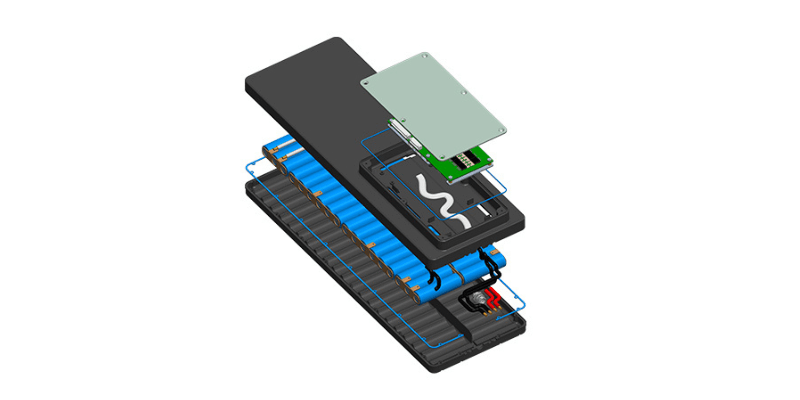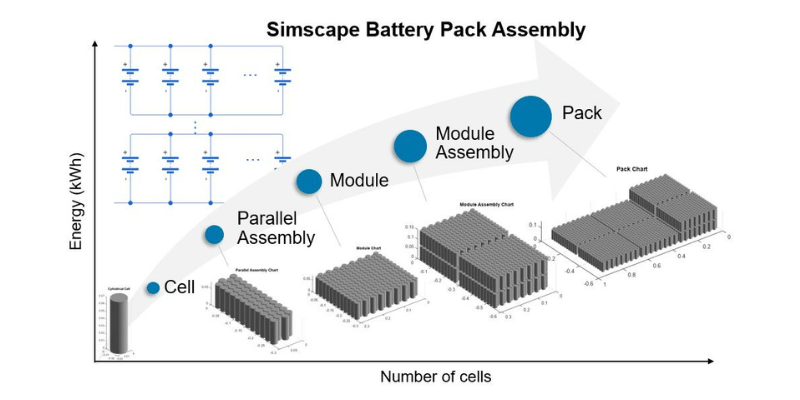Att förstå skillnaderna mellan battericeller, moduler och paket är avgörande för att designa effektiva energilagringssystem. Den här artikeln utforskar deras konstruktion, prestandaegenskaper och tillämpningar.
Battericell
Vad är en battericell?
En battericell är grundenheten i ett batteri, som fungerar som en liten behållare som lagrar och frigör elektrisk energi genom kemiska reaktioner. Den består av elektroder (anod och katod) åtskilda av en elektrolyt och innesluten i ett hölje. Flera celler kan kombineras för att bilda ett större batteri med högre spänning eller kapacitet.
Battericellsdesign
Storlek
Battericeller sträcker sig från små i elektronik till stora celler i elfordon, vilket påverkar kapacitet och energitäthet för specifika tillämpningar.
Form
Battericeller kommer in cylindrisk, prismatisk, och påsdesigner.
Cylindriska celler:
- Fördelar: Robust, konsekvent prestanda, hög energitäthet.
- Nackdelar: lägre specifik energitäthet än vissa format.
- Applikationer: bärbara datorer, elverktyg, bärbar konsumentelektronik

Påseceller:
- Fördelar: Hög energitäthet, flexibel design, kostnadseffektiv.
- Nackdelar: Risk för svullnad, kräver noggrann termisk hantering.
- Applikationer: smartphones, surfplattor
Prismatiska celler:
- Fördelar: Hög energitäthet, effektiv termisk hantering, skalbar design.
- Nackdelar: Mindre flexibilitet än påseceller.
- Applikationer: Elektriska fordon, energilagringssystem, industriella applikationer.
Intern kemi
En battericells interna kemi bestämmer dess prestanda, inklusive spänning, kapacitet och kretsloppsliv. Olika kemister, såsom litiumjon, nickel-metallhydrid och bly-syra, erbjuder olika avvägningar i energitäthet, kostnad och säkerhet. Till exempel gynnas litiumjon för sin höga energitäthet i bärbara enheter.
Elektrodmaterial
Elektrodmaterial påverkar signifikant battericellprestanda och livslängd. Vanliga alternativ inkluderar litiumkoboltoxid (LICOO2), litiumjärnfosfat (LifePO4) och nickelmangankoboltoxid (NMC). Var och en erbjuder distinkta energitäthet, stabilitet och säkerhetsprofiler anpassade efter specifika behov.
Förpackning och inkapsling
Battericeller är inrymda i skyddande förpackningar för att förhindra skador från miljöfaktorer. Förpackningen måste ge isolering för att undvika elektrolytläckage samtidigt som den säkerställer långsiktig tillförlitlighet; korrekt inkapsling tar också upp risker som termisk flykt eller kortslutningar.
Vanliga förpackningsmaterial inkluderar:
- Metallburkar: Dessa skyddar cylindriska celler och förhindrar kortslutning.
- Aluminiumpåsar: De erbjuder ett flexibelt, lätt hölje för påsceller.
- Metallhöljen: Dessa skyddar prismatiska celler och hjälper till med värmehantering.

Batterimodul
Vad är en batterimodul?
En batterimodul består av anslutna battericeller inrymda i ett hölje. Det ökar spänningen och kapaciteten hos ett batterisystem och fungerar som en länk mellan enskilda celler och hela batteripaketet.
Batterimoduldesign
Storlek och form
Batterimodulens storlek och form varierar beroende på applikation och önskad energieffekt. Vanliga konfigurationer inkluderar:
- Moduler av påstyp: Flexibla och lätta, används i hemelektronik och elfordon.
- Prismatiska moduler: Styva och stapelbara, vanligen förekommande i elfordon och energilagringssystem.
- Cylindriska moduler: Tillverkade av cylindriska celler, erbjuder hög energitäthet och mekanisk robusthet.
Intern kemi och elektrodmaterial
Battericellernas kemi och material påverkar den totala prestandan. Nyckelfaktorer inkluderar:
- Anodmaterial: Vanliga alternativ är grafit, kisel och litiumtitanatoxid (LTO), var och en erbjuder unika fördelar.
- Katodmaterial: Litiumkoboltoxid (LCO), litiummanganoxid (LMO), litiumjärnfosfat (LFP) och nickel-kobolt-aluminiumoxid (NCA) skiljer sig i energitäthet, effekttäthet och livslängd.
- Elektrolyt: Typiskt en vätska eller fast substans som underlättar jonrörelse mellan anoden och katoden.

Förpackning och inkapsling
Modulens förpackning skyddar interna komponenter samtidigt som säkerheten garanteras. Viktiga överväganden inkluderar:
- Modulhölje: Det ska vara starkt, kemiskt resistent och värmeledande.
- Cellsammankoppling: Pålitliga ledningstekniker är viktiga för cellanslutningar.
- Termisk hantering: Förhindrar överhettning med hjälp av kylflänsar eller fasförändringsmaterial.
- Säkerhetsfunktioner: Inkludera säkringar, strömbrytare eller övertrycksventiler för att minska riskerna.
Batterihanteringssystem (BMS)
Ett BMS är ett måste för att övervaka parametrar som:
- Cellspänning: Säkerställer jämn laddning och urladdning över celler.
- Celltemperatur: Förhindrar överhettning eller överdriven kylning.
- Laddningsläge (SOC): Spårar återstående kapacitet.
- Hälsotillstånd (SOH): Uppskattar batteriets livslängd.

Batteripaket
Vad är ett batteripaket?
Ett batteripaket består av battericeller eller moduler anslutna för att bilda en enda strömkälla. Celler är ordnade i serie och parallellt för att uppnå önskad spänning och ström. Batteripaket kan innehålla en cell eller tusentals.
Design av batteripaket
Battericellsarrangemang:
- Bestäm erforderlig spänning och kapacitet.
- Välj battericellstyp och storlek (t.ex. litiumjon, litiumpolymer) baserat på prestandabehov.
- Bestäm serie- och parallellkonfigurationer för att uppnå önskad spänning och kapacitet.
- Säkerställ enhetlighet i cellspecifikationer för att upprätthålla balans.
Design av huset:
- Välj material för batteripaketet som säkerställer styrka, hållbarhet och effektiv värmehantering.
- Designa höljet så att det rymmer battericeller effektivt. Inkludera kylventiler, kylflänsar eller isolering för temperaturreglering.
- Skydda cellerna från fysisk skada och miljöfaktorer som fukt och damm.

Säkerhetsfunktioner:
- Integrera ett BMS för att övervaka laddning, urladdning och temperatur.
- Inkludera skydd för överladdning, överladdning, kortslutningar och termisk rusning.
- Installera säkringar eller strömbrytare för nödisolering.
- Säkerställ överensstämmelse med UN/DOT-regler och UL-certifieringar.
Elektriska anslutningar:
- Designa lågresistans elektriska anslutningar mellan celler/moduler/terminaler för att minimera energiförlusten.
- Använd material av hög kvalitet för pålitliga anslutningar som minskar spänningsfall eller fel.
- Implementera isolering och skärmning för att förhindra ljusbågar, korrosion och elektromagnetiska störningar.
Testning och validering:
- Genomför noggranna tester av designprestanda under olika förhållanden.
- Utför stresstester som temperaturcykling, vibrationstestning; bedöma hållbarheten.
- Validera överensstämmelse med industristandarder genom rigorösa testprotokoll.
Batteripaketapplikationer
- Bärbar elektronik: Batteripaket driver mobila enheter som smartphones, surfplattor och bärbara datorer, och erbjuder praktiska lösningar när du är på språng.
- Elektriska fordon: Batteripaket är den primära energilagringen i EV: er, vilket ger framdrivkraft för utsläppsfri transport.
- Stationär energilagring: Batteripaket förvarar överskott av energi från förnybara källor som sol och vind, vilket möjliggör säkerhetskopiering, nätstabilisering och belastningsförskjutning.

Vad är skillnaden mellan battericell, batterimodul och batteripaket?
För att förstå skillnaderna mellan battericeller, moduler och förpackningar, låt oss bryta ner varje komponent:
- Battericell: Den grundläggande enheten för energilagring som omvandlar kemisk energi till elektrisk energi. Den finns i olika former (cylindrisk, prismatisk eller påse) och innehåller en anod, katod, separator och elektrolyt.
- Batterimodul: En grupp sammankopplade battericeller som ökar spänningen och kapaciteten jämfört med enskilda celler. Den inkluderar kablar och kontakter och kan ha ett grundläggande batterihanteringssystem (BMS) för övervakning.
- Batteripaket: Ett komplett energilagringssystem som innehåller en eller flera moduler. Den innehåller ett avancerat BMS för cellbalansering, temperaturkontroll och säkerhetsfunktioner, samt ytterligare komponenter som hölje och värmeledningssystem.
Sammanfattning:
- Battericell: Den minsta enheten.
- Batterimodul: En grupp anslutna celler.
- Batteripaket: Ett komplett system med moduler och ett BMS.
Analogi:
- Battericell: En enda tegelsten.
- Batterimodul: En vägg gjord av flera tegelstenar.
- Batteripaket: En byggnad gjord av flera väggar.

